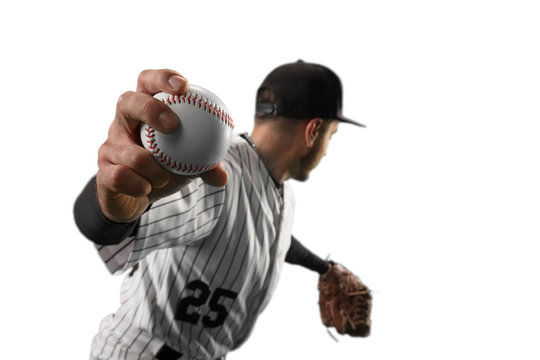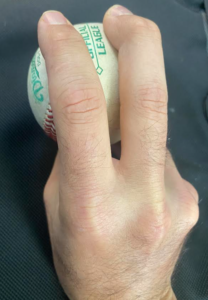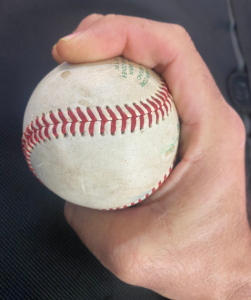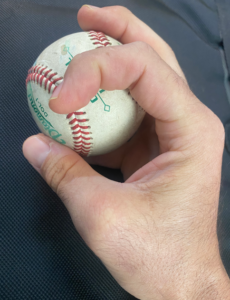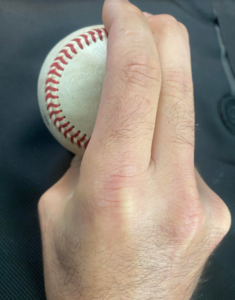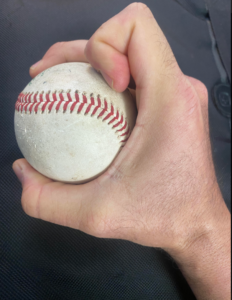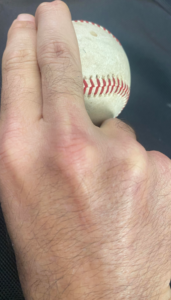Baseball pitchers throw a variety of different pitches to keep batters off balance and try to win the one-on-one battle to get an out.
In little league baseball, you may only see pitchers throw one or at most two types of pitches, while you may see up to 8 different types of pitches in a major league baseball game.
The more advanced the hitters, the more complex the pitches and skill sets are required in order to get the hitters out.
Contents
Top 9 Different Baseball Pitch Types
Let’s take a look at the most common pitch types that baseball pitchers use during baseball games.
1. Four-Seam Fastball
The four-seam fastball is the most common type of pitch that is thrown during a baseball game. This type of pitch is called a four-seam fastball because the four seams are rotating in order which helps generate a straight fastball.
A four-seam fastball is the easiest pitch to control and one that most little league players start with. Many pitching coaches refuse to let pitchers experiment with other types of pitches if they struggle to locate a four-seamer since its viewed as the primary pitch to master.
Four-seam fastballs are also the hardest thrown pitches because of the aerodynamic spin that is generated on the ball. If a pitcher has above-average velocity and can generate swings and misses on a four-seam fastball they will likely have much success if they can throw strikes consistently.
On the other hand, if a pitcher has average to below-average pitching velocity, a four-seam fastball can get hit easily by good-hitting teams and a pitcher will need to rely more on off-speed pitches.
Nolan Ryan had one of the best fastballs in major league baseball history and also used his fastball to send messages to hitters.
2. Two Seam Fastball
The two-seam fastball is another pitch in the fastball family that is typically the second pitch a pitcher will try to master. The two-seamer is thrown exactly like the four-seam fastball with the only difference being the grip on the ball.
A two-seam grip is typically held one of two ways that result in the baseball tailing to the right for a right-handed pitcher and tailing to the left for a left-handed pitcher. Two-seam fastballs are around 2-4 MPH slower than four-seam fastballs.
A right-handed pitcher with a good two-seam fastball can throw it in on a right-handed hitter, generate arm-side movement, and make it very difficult to get a barrel on it and the same goes for left-handed pitchers against lefty hitters.
Pitchers with very good control will also throw back-door two-seam fastballs that come back across the outside of the plate. A backdoor two-seam fastball takes an incredible amount of skill because one that is slightly misplaced will tail back over the middle of the plate and can get end up getting crushed by a good hitter.
Brandon Webb and Greg Maddox were two of the best at throwing back door two seamers:
3. Curveball
When it comes time for pitchers to start experimenting with other pitches besides fastballs a Curveball is one of the most common off-speed pitch options that most pitchers move to next. A curveball is in the “breaking ball” family and is pitch that is thrown with sharp downward movement on the ball.
Curveballs at the Major League Level can range anywhere from around 70MPH up to 85 MPH or so and are used at various times during at-bats. Many pitchers will throw a first-pitch curveball for a strike to get ahead of unsuspected hitters and stay in favorable pitcher counts.
Most of the curveballs are thrown in 1-2 or 0-2 counts when pitchers are looking to put hitters away by hoping they chase a difficult off-speed pitch like a curveball or slider. Many television announcers will refer to curveballs and sliders as a breaking ball throughout the course of a game, so it may be difficult to tell the difference between the two.
The main difference between a curveball and slider is the angle of the break in the ball as well as the velocity and spin rate.
Barry Zito and Adam Wainright are two pitchers that were able to have long MLB careers due to their ability to command their curveballs at any count in a game:
4. Slider
A slider is very similar to a curveball except in the fact that a slider is thrown harder and typically has more of a side-to-side lateral break instead of a downward angle like a curveball.
Hitting coaches teach hitters to look for “the dot” on sliders which means to pick up the spin out of the pitcher’s hand that a slider is on the way. Sliders spin with sideways spin on the ball which gives the ball a noticeable red dot in the middle of the ball when it is coming at a hitter.
Major League sliders are thrown anywhere from 80 MPH to the low 90s and are one of the toughest pitchers to hit for hitters. Because a slider is designed to look like a fastball out of the hand it can be very difficult for hitters to pick up a good sharp slider.
On the other hand, many pitchers struggle to command the slider and leave the pitch hanging over the plate resulting in what’s known as a flat slider.
5. Changeup
A changeup is an off-speed pitch that is intended to come out of the hand looking like a fastball but actually be around 10 miles per hour slower. Hitting is all about timing and the changeup is a great pitch to incorporate into a pitching arsenal that keeps hitters off balance.
The changeup is a tough pitch to control because it takes exceptional touch off of the fingertips to slow down the ball while maintaining the same arm speed as your fastball.
Circle changeup
A circle changeup grip is a type of changeup that is thrown with a unique grip with the index finger and thumb forming an “ok” sign on the inside part of the ball.
The circle changeup typically has some tailing action on the ball similar to how a two-seam fastball moves. Youth baseball players normally start throwing a “straight changeup” and then advance to throwing the circle changeup when they get a good command of the ball
6. Split Fingered Fastball
A split-fingered fastball requires large hands and is a pitch you will most likely see in professional baseball. Throwing a “split” is one of the toughest pitches to throw for strikes because of the unique grip that is placed on the ball.
As a former pitcher, I tried to throw a split many times but had a difficult time locating this pitch for strikes. Pitchers that can locate a split-finger fastball often get mad respect from other pitchers on the team because most realize it is one of the most difficult pitches thrown.
John Smoltz had one of the best split-fingered fastballs in MLB history that he threw from both the starting and closer roles throughout his career for the Braves:
5. Cut Fastball
A cut fastball is another pitch in the fastball family that you typically only see at the advanced levels of baseball. Cut fastballs are thrown harder than sliders and don’t have as much break, but they have just enough movement to create confusion for hitters.
Cut fastballs are difficult to learn how to throw because if you throw a cut fastball that doesn’t cut enough the pitch will be very easy for good hitters to hit. Cut fastballs are about 5-8 MPH slower than a typical fastball and a good cut fastball in professional baseball has the tendency to break wooden bats frequently.
Marino Rivera had one of the best cutters in baseball history he used to saw off plenty of bats over the years and used his cutter as his primary pitch.
6. Knuckle Curve
A knuckle curve is a curveball offshoot that involves a pitcher’s index finger pinching the ball or having their index finger knuckle pressed against the ball while the middle finger rests along the seem like a typical curveball.
The knuckle curve is thrown just like a regular curveball; the only real difference is the grip. Some pitchers prefer the knuckle curve grip because they feel like it allows them to hold the ball deeper in their hand and generate more spin.
7. KnuckleBall
The knuckle ball is a rare pitch that involves using one’s knuckles or fingertips to “push” the ball and generate as little of spin as possible.
Knuckleballs that are thrown correctly are one of the hardest pitches to hit in baseball but are also one of the toughest pitches to throw.
Most pitchers that are knuckleball pitchers started out as regular pitchers but reached some sort of ceiling in their careers due to physical ability. Once pitchers start to realize they don’t throw hard enough to get hitters out consistently they may start to experiment with throwing sidearm or throwing knuckleballs.
Tim Wakefield is one of the most notable knuckleball pitchers in baseball history and is a perfect example of a pitcher who pivoted to the knuckleball after hitting a wall in his career:
8. Screwball
A screwball is a pitch that moves in the opposite direction of a traditional breaking pitch and has a similar action as a circle changeup. Screwballs aren’t encouraged by most coaches because of the stress it can place on the elbow if it is thrown incorrectly.
Throwing a screwball requires torquing one’s wrist at an angle that puts stress on the ulna collateral ligament (UCL). The UCL is the ligament that pitchers and coaching fear injuring since it likely results in Tommy John surgery and a lengthy rehab process.
Hector Santiago was tabbed as baseball’s last remaining screwball pitcher a few years ago because of the rarity of seeing this pitch thrown.
9. Spitball
A spitball is a pitch that involves pitchers using a substance on the ball like vasoline to or another slick substance so that the ball slides off the pitchers’ fingers in a way that creates movement on the ball.
The spitball was popular in early baseball days when pitchers commonly doctored baseballs to gain a competitive advantage over hitters. In 1920 baseball leagues began to start enforcing rules against throwing spitballs by banning baseballs that were doctored.
Many pitchers continued to throw the controversial off-speed pitch through the years and were able to hide it from umpires quite well. Many pitchers admitted to throwing spitballs or defective balls but the most notable spitball pitcher was Gaylord Perry.
Gaylord Perry had an extensive pre-pitch routine that is quite laughable if you compare it to today’s pitching motions:
FAQ
What are the illegal pitches in baseball?
The Quick pitch is the most common illegal pitch called in today’s game. Quick pitching is when a pitcher doesn’t come to a complete set and tries to throw the ball to the catcher in a way that keeps the hitter off balance. The spitball is another type of illegal pitch and in today’s game, any pitch that is thrown with a non-approved pitching substance such as pine tar results in immediate ejection.
What is the rarest pitch in the MLB?
The screwball is the most rare legal pitch that you will see during a major league baseball game because of the injury risk that comes along with throwing this type of baseball pitch.
Summary
All of the different pitches in baseball are one of the reasons baseball is such a fascinating sport to play and watch. Pitchers use a variety of pitches to attack the strike zone and keep hitters guessing at different times throughout a baseball game. Fastballs, breaking balls, sliders and changeups are the most popular pitch types you will hear described during the course of a baseball game but as you see there are plenty of others to keep an eye out for!

